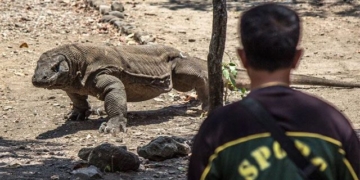Cute-looking animals often attract people’s attention. However, in nature, there are many species that appear adorable and innocent, but the reality about them is entirely different from their appearance.
1. Giant Panda
First on this list is the giant panda, which has a very cute appearance and is beloved by people around the world.
However, giant pandas are not strictly herbivorous; besides bamboo, they also eat meat. Their bamboo diet is merely an adaptation to their living environment. One little-known fact is that they have a nickname “iron-eating monster,” as they possess a powerful bite compared to their relatives. Their bite force ranks just behind that of the polar bear and the brown bear. Despite their cute appearance, it is unwise to provoke them.

Their bite force ranks just behind that of the polar bear and the brown bear.
Contrary to the misconception that pandas prefer to live in groups, they actually favor solitude and tend to avoid direct contact with others of their kind. Each year, male and female pandas only meet during the mating season for about 2 to 3 days in spring (from March to May). After that, the male will bid farewell to the female and return to enjoy a solitary life until the next mating season.
It may sound unbelievable, but even though 99% of this species’ diet consists of bamboo and related plants, they belong to the carnivore order. An adult panda needs to consume at least 18 kg of bamboo leaves daily. Wild pandas sometimes eat grass, wild tubers, bird meat, rodents, and even carrion. Captive pandas can also eat honey, eggs, fish, carrots, sweet potatoes, shrub leaves, and various fruits such as apples, oranges, or bananas.
2. Pallas’s Cat
Second on this list is the Pallas’s cat, also known as manul or “thick-tailed cat.” Despite its name, it does not resemble a rabbit at all.
This wild cat has round eyes and a small body. Although small in size, it is one of the most ferocious species in the cat family.
They are very aggressive, with excellent vision and hearing, which are advantageous for hunting prey and escaping danger from larger predators.

This cat looks cute but is one of the most aggressive in the cat family.
Unlike common domestic cats, Pallas’s cats have flatter and shorter faces. Their teeth are also fewer in number compared to other cats. The cheeks have a stripe of white fur that runs from the corner of the eye down to the chin. Their legs are quite short but well-proportioned. Their gait appears agile and graceful, endearing them to many cat lovers worldwide. Pallas’s cats have short ears that are set far apart, which is a unique feature of this breed.
This breed is regarded as an exceptionally skilled predator. They have the ability to hide, stalk, and catch prey accurately. Their agile minds, honed daily, help them survive well in the wild.
Being a wild cat, they prefer to live alone and solitary. In their territory, they often choose caves, crevices, or rocky hollows as their hiding places. Therefore, the personality of Pallas’s cats is not at all gentle like domestic cats. They are always wary of humans and any other animals. Even when they are born, the kittens, with their eyes still closed, already know how to growl to threaten enemies.
3. Honey Badger
Honey badgers can be found in most areas of sub-Saharan Africa, Saudi Arabia, Iran, and Western Asia. They can adapt to various conditions, from warm rainforests to cool mountainous regions. Their territorial range can extend up to about 193 square miles (500 square kilometers).
Most honey badgers are active throughout the day; however, when living near human settlements, they often operate at night.

Honey badgers have a long body, measuring between 55 to 77 cm.
This animal is very skilled at turning crevices and hollow trees into shelters. Honey badgers will also convert the abandoned “homes” of other animals, such as hedgehogs and meerkats, into their own shelters.
Honey badgers have a long body, measuring between 55 to 77 cm, with a shoulder height of about 23 to 28 cm, and a tail length of 12 to 30 cm. Females are usually slightly smaller than males. Males weigh between 9-16 kg, while females weigh only 5 to 10 kg. However, honey badgers are very agile and… fearless. They are not intimidated even by lions, so stealing food from foxes, hyenas, and leopards is quite normal. Honey badgers are considered one of the least concern species due to their wide distribution and high adaptability to many environments. They primarily eat other animals, as few species in the wild can defeat honey badgers because of their extremely fierce defense.
Honey badgers are famous for being very aggressive; they often try to avoid a fight. However, when confronted, they do not hold back, and sometimes people even witness them fighting with hyenas, lions, leopards, and giant pythons.





















































